Formula 1: 2020 championship too close to call as pre-season testing ends
- Published
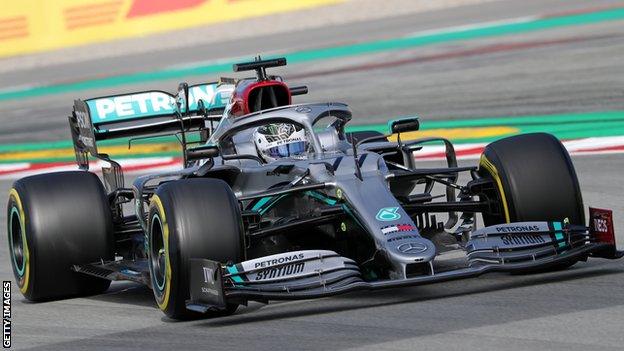
Valtteri Bottas won last year's Australian Grand Prix, which is live on 5 Live and the BBC Sport website on 15 March
The Formula 1 teams have completed their pre-season testing programmes and the shape of this year's competition is beginning to emerge.
It is notoriously difficult to form any firm conclusions from testing because the number of potential variables is just too high.
But most Formula 1 insiders seem to agree on a handful of things - Mercedes will start the season in Australia in mid-March as favourites, Red Bull and Ferrari are hard on their heels, the midfield fight looks very close indeed, and the best teams in it appear to have moved closer to the front.
Let's take a closer look at how things appear to be shaping up.
The champions
Red Bull team principal Christian Horner summed up the general view of Mercedes on the final day of testing in Spain.
"Mercedes are very much the favourites," he said. "Their form has looked strong."
Mercedes hit the ground running on the first day of winter testing, when Valtteri Bottas and Lewis Hamilton set the two fastest times, and have hardly looked back since.
And Bottas ended the pre-season as he started it - with the fastest time on the final day.
As everyone who knows anything about F1 understands, a fast single lap time in testing means nothing in isolation. But the impressive way in which Mercedes went about their business throughout the six days in Spain was what led people to believe they are in front.
As Ferrari driver Sebastian Vettel put it: "You'd say Mercedes is at the top because, every time they go out, they are fairly quick with ease, not just one lap, but in general. Whereas others need to stretch a bit more."
Mercedes also caught their rivals on the hop with an innovative technical development that emerged in the course of the first week.
Their so-called 'dual-axis steering' - a clever way to alter the angle of the front wheels between cornering and straights that appears to be aimed at improving tyre wear - got everyone talking and will likely take rivals months to copy, if they even can at all.

Typically the front wheels on an F1 car are mounted at an outward-facing angle to help with cornering (yellow dotted line) - this system adjusts them to be more centred (red line) travelling down the straights when the driver pulls back the steering wheel
But Mercedes are not without their concerns, and the biggest one surrounds reliability.
Hamilton was stopped by an engine problem on the penultimate day of running, team-mate Bottas had two separate engine-related issues, Williams driver Nicholas Latifi lost a lot of mileage with three, and his team-mate George Russell also had an issue on the final day.
This is a significantly worse reliability record than rivals Ferrari and Honda, who supply Red Bull.
Hamilton said: "It's a concern, yeah, for sure. Normally in this pre-season testing we're much more confident in the reliability so it's not been perfect for us. I think we're on our second engine already.
"It's definitely not an easy or relaxed scenario for us. But I have every confidence in the guys back in the factory that they will analyse and do the best they can in these next two weeks to make sure we start off on the right foot."
Red Bull
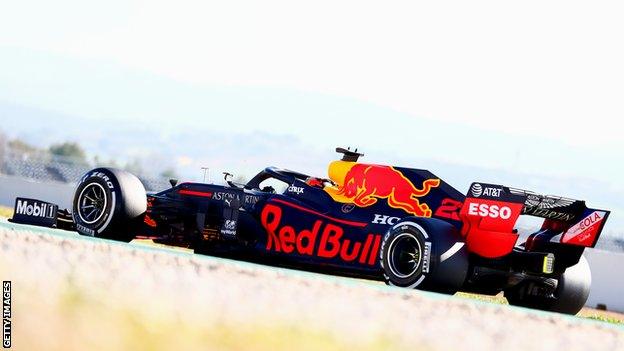
On a general level, the same top three teams are expected to remain at the front, with Mercedes challenged by Red Bull and Ferrari. But the exact state of play between them is unclear.
Red Bull always play their cards close to their chest in pre-season testing, and this year was no different. Horner said they were "pretty satisfied" with what had been a "pretty positive" pre-season, while lead driver Max Verstappen said: "The car has been feeling good and (it's) definitely an improvement from last year."
It was notable that Red Bull did not use the softest tyres to set their fastest times, unlike most of the other leading teams, and the car looked quick out on track.
The main question mark over Red Bull surrounded the number of spins the car had. Verstappen lost control of it six times in six days - three times as much as any other driver. And team-mate Alexander Albon had a similar spin on the final day of testing.
Observers questioned whether the car had a rear instability issue, perhaps triggered by an interruption of the airflow in long corners.
But Verstappen shrugged these claims off, saying he was merely exploring the car's limits in testing. "They don't drive the car, so they don't know," he said of those questioning its behaviour. "I am not worried at all."
Ferrari
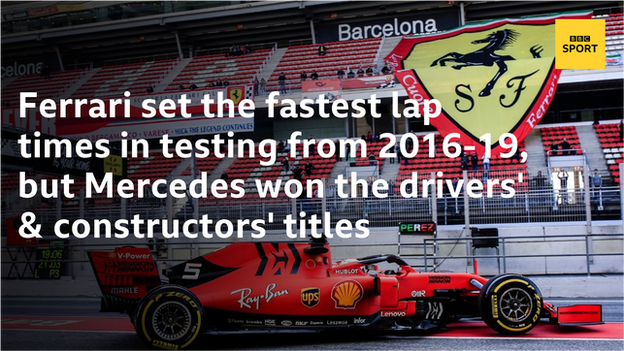
As for Ferrari, team boss Mattia Binotto has been ultra-cautious in his public pronouncements so far.
"We are certainly not the fastest car during winter testing," he said. "Our main competitors are faster but it is only the start of a long season. There will be time to address development where we are weak. We have been quite reliable and in that respect it's positive."
Rivals suspected Ferrari were 'sandbagging', or hiding their true pace.
"We are not hiding," Binotto said. "That is our true performance. We are down on speed compared to other competitors."
Until Friday, Ferrari had indeed appeared to be struggling, and some were even suggesting they may find themselves in competition with the fastest midfield runners, particularly the impressive new Racing Point.
But that idea looks like it can be put to bed now. Not only did Charles Leclerc show some strong one-lap pace on Friday morning, but more importantly in the afternoon he did a highly impressive race-simulation run.
Not only was it on average a second a lap faster than the Racing Point of Sergio Perez, who was doing a 'race sim' at the same time, but it was in the ballpark of similar runs Mercedes had done earlier in testing.
The one exception was one ultra-fast long run done by Hamilton on the second day last week, when track conditions were at their best, and the world champion's pace was on a separate level from anything any other driver and team achieved.
Was that an outlier, or a measure of Mercedes' true pace? It cannot be known.
Putting that Hamilton run to one side for now, the first stint of Leclerc's race run on Friday matched lap for lap one Hamilton started on Thursday before his engine problem intervened. Leclerc's race pace was also almost identical over its full distance to a run Bottas did in the first week. And it was slightly faster than Verstappen's race sim completed on the final day of the first test.
Of course, these runs cannot be compared directly in a definitive sense, not least because they were done at different times on different days. They are merely clues as to where things might be.
And another caveat is that Red Bull produced a significant aerodynamic upgrade for the second test, and did not do a race sim with that.
Overall, though, it appears as if Ferrari are very much in the ballpark after all.
The midfield
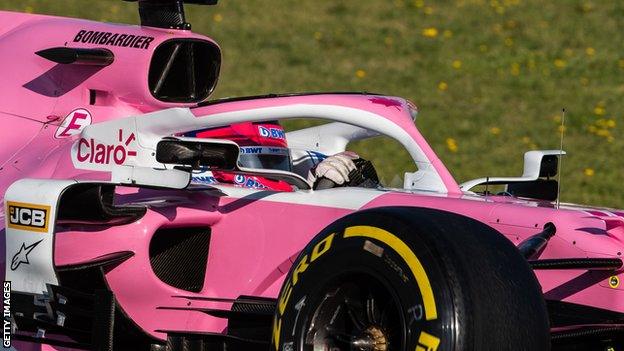
Racing Point's new car has turned heads in Barcelona
The Racing Point won a lot of attention in the course of testing - both for the way it looked and the way it went.
It quickly became known as the 'pink Mercedes' for its striking resemblance to last year's title-winning car, which you did not have to be an expert in aerodynamics to spot.
Rivals were concerned about exactly how Racing Point had managed to make the car look quite so much like a Mercedes, a team with whom they have a commercial agreement to buy engines gearboxes and various suspension parts, because sharing information on aerodynamics is banned.
Racing Point were quick to fight back, saying they had not done anything wrong, that they had merely copied the Mercedes from photographs - and why wouldn't they, given that it was the fastest car, and what they bought from the world champions led them in that direction anyway?
"I don't know what they are complaining about," technical director Andrew Green said, adding: "It gives me encouragement people are complaining about us. That is a good indication to me we are doing something really good. If we were at the bottom of the pack, no-one would be mentioning what we're doing at all."
They were certainly not at the bottom of the pack; in fact, many believed they looked like they might be heading the midfield behind Mercedes, Ferrari and Red Bull and, controversially, ahead of McLaren and Renault, who very much go their own way with car design.
Are Racing Point at the head of the midfield? It's hard to be sure. They certainly look there or thereabouts. But McLaren's Carlos Sainz was out on a race run at the same time as Perez on Friday, and while the Racing Point started with an advantage, the McLaren seemed to catch up about halfway through and if anything be slightly ahead by the end.
The feeling seems to be that Racing Point, McLaren and Renault will start the season at the head of the midfield, in an order that it is hard to divine, before a bit of a gap back to the two teams who confusingly share half a name - Alpha Tauri, the new name for the Red Bull junior team formerly known as Toro Rosso, and Alfa Romeo.
Haas and Williams appear to be somewhere in that second-group mix, too. And Williams - to the relief of their many fans around the world - look to have clawed their way back to respectability, after spending 2019 close to two seconds adrift of the back of the field.
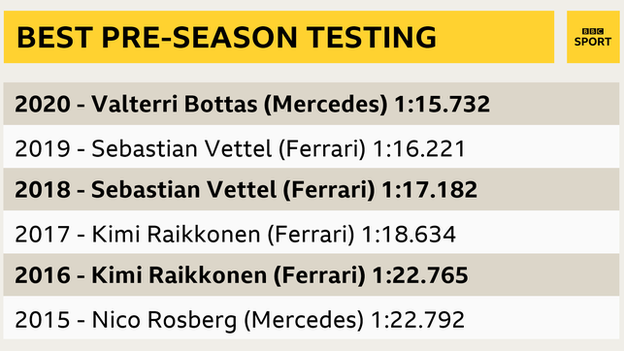
The coronavirus threat
With testing over, F1 teams and drivers are now in a state of combined nervousness, excitement and anticipation about going to Australia and, as Vettel puts it, "pulling our pants down and seeing what we've got".
But the threat of the coronavirus hangs over this sport, as it does over all others.
Will F1 actually be able to race in Australia, or Bahrain a week later, or Vietnam a fortnight after that? F1 says everything is going ahead as planned, but the situation is changing quickly.
From an F1 point of view, this is a multi-faceted problem.
Beyond the obvious concerns about health, there are also serious practical and logistical problems well beyond the sport's control.
Italy and Japan, for example, are two of the countries where virus outbreaks are at their most severe. Japan is the base of Honda, which supplies engines to Red Bull and Alpha Tauri. Italy is not only the home of Ferrari, who supply assistance to Haas and Alfa Romeo, but also Alpha Tauri and tyre supplier Pirelli.
What happens if one of the countries holding one of the opening races decides to ban entry to Japanese or Italian nationals, or those of any other country, between now and when people starting flying to Melbourne in a week or so's time?
"What we will need is simply to have assurance before leaving," Binotto said. "I don't think we can discover when on a plane what can be or what will be the situation.
"We need to understand what are the consequences in case of a problem. Because we need to protect our employees. We've got a collective and individual responsibility towards them. We need to make sure that, before leaving, the picture is known and clear."
What if Ferrari can't make it to a race? In the context of what that would mean for the integrity of competition, when millions of pounds are at stake, never mind the huge global exposure of the world championship, would that event run without them? Could it?
Right now, the Australian Grand Prix is going ahead on 13-15 March. Will that still be the case in a few days' time? At this stage, the truth is, no-one knows.
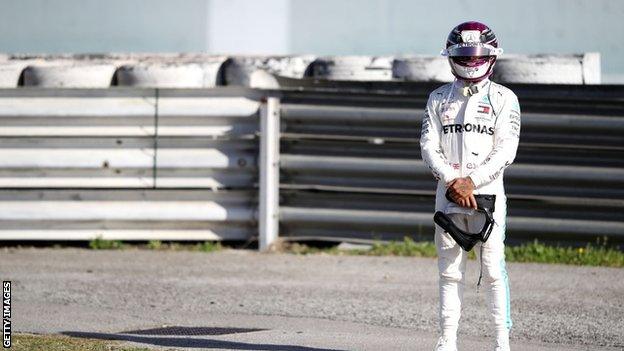
Fastest times by each team in pre-season testing
1 Mercedes (Valtteri Bottas) one minute 15.732 seconds **
2 Red Bull (Max Verstappen) 1:16.269 *
3 Renault (Daniel Ricciardo) 1:16.276 **
4 Ferrari (Charles Leclerc) 1:16.360 **
5 Racing Point (Sergio Perez) 1:16.634 **
6 McLaren (Carlos Sainz) 1:16.820 *
7 Williams (George Russell) 1:16.871 **
8 Alpha Tauri (Daniil Kvyat) 1:16.914 *
9 Alfa Romeo (Robert Kubica) 1:16.942 **
10 Haas (Romain Grosjean) 1:17.037 *
** = C5 tyre (fastest); * = C4 tyre (second fastest)
